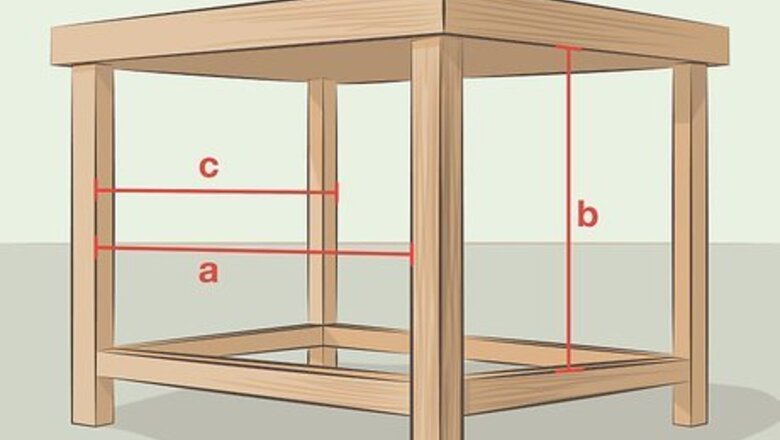
views
Installing the Spacers

Measure the available space under your workbench. Take a tape measure and check the height, length, and width of the space under the workbench. Write each dimension down so you don’t forget it. Use these measurements to cut the wood to the correct size. Remember that you’re only measuring the space underneath the bench, not the whole workbench. Measuring the whole bench will make your measurements too large. Measure at every step of this project to confirm that your sizing is all correct. If any of your measurements are off, the drawers and runners will be the wrong size.
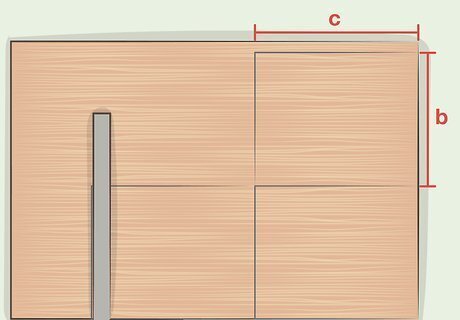
Measure and mark 3 pieces of plywood to fit under the bench. These plywood sheets will form the spacers for the drawers. Standard, ⁄2 in (1.3 cm) thick plywood is ideal. Measure each one to match the height and length of the space under the bench bench. Use a straightedge to mark each board to the correct dimensions. Each spacer will be installed vertically, meaning their edges will point up and down. The idea of cutting them it to make sure they slide into the space under the bench while pointing vertically. If the space under your workbench is a length of 30 inches (76 cm), and a height of 40 inches (100 cm), then measure the boards to cover those dimensions. Each board should have the same dimensions, unless the bench is crooked or wasn't built straight. If the plywood boards are too small for the workbench, you can use multiple boards in a row or, if you’re not installing that many drawers, just leave the boards short. If you want to fill all the space under the bench, you can probably fit 2 or 3 columns of drawers that are 6 inches (15 cm) deep and 12 inches (30 cm) wide, although this depends on the size of your workbench.
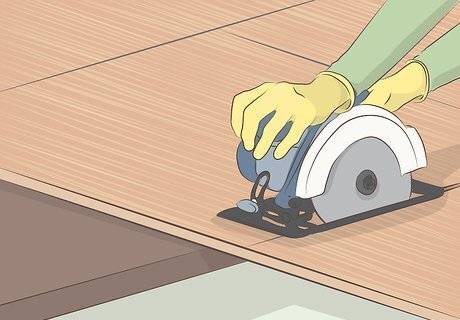
Cut the pieces of plywood sheets along the lines. Use a table saw or circular saw. Cut along each line you drew on the plywood. Keep the saw straight so your cuts aren’t off. Always wear goggles and gloves when using a power saw. Keep your fingers at least 6 inches (15 cm) away from the blade while it’s spinning. For the straightest cuts, a table saw is best. If you don’t have a table saw, then pay close attention to staying on the lines with a circular saw. Test each piece before moving on. Make sure it slides underneath the bench easily.
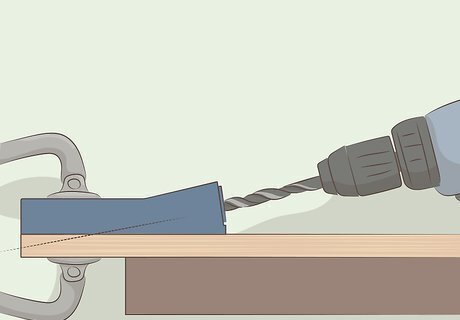
Drill one pocket hole into each corner of the plywood sheets. Pocket holes are drilled at a 15-degree angle with the wood to make a path for a diagonal screw. Use a power drill and make a pocket hole in each corner of the plywood, where the sheet will attach to the bench. Each sheet should have 4 holes, 1 in each corner. Drilling diagonally is dangerous and you could slip. Keep your hand out of the way of the drill to avoid accidents. There are pocket hole molds that make drilling the holes easier. Get one from a hardware store and clamp it to the wood. Drill through each of the guide holes for perfect pocket holes.

Attach a plywood sheet to each side of the workbench. Take the first 2 sheets and slide them into the workbench on each side. Let the sheets rest on the support beams that run across the front and back of the bench, if the bench has these. Make sure the sheets are flush with the front and back of the bench. Hold them in place and drill a screw through each of your pilot holes and into the bench. If the sheets make a tight fit, use a rubber mallet and tap them into position. If the sheets are short, then lift them so they touch the top of the bench and clamp them in place. Then screw them in. This assumes that your workbench is made of wood, which most are. If your bench is made of metal, then you'll have to pre-drill holes through the metal and attach the boards with nuts and bolts.
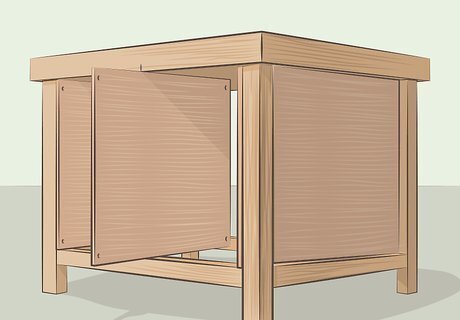
Install the third sheet directly in the middle of the workbench. Measure and mark the point directly in the middle of the bench. Then slide the third sheet into position at that point. Make it flush with the front and back of the bench. Drill screws through the pocket holes to secure it to the bench. If there is 48 inches (120 cm) between the two sides, then make a mark at 24 inches (61 cm). This is only if you want your drawers to be equal sizes. If you want one drawer bigger than the other, then attach the spacer accordingly. The the bench has horizontal support beams, the spacers should rest on them. If not, they can rest on the floor.
Building the Drawers

Measure the width between each spacer in the workbench. This determines the width of each drawer. Use your tape measure and check the distance between each spacer. Write these measurements down and use them to make your drawers. Take special care to measure exactly if you’re making drawers that aren’t the same size. Confirm how much space you have for each one. Even if you made the spacers equal-distance apart, still measure each side to confirm. Otherwise, your drawers might not be the right size.
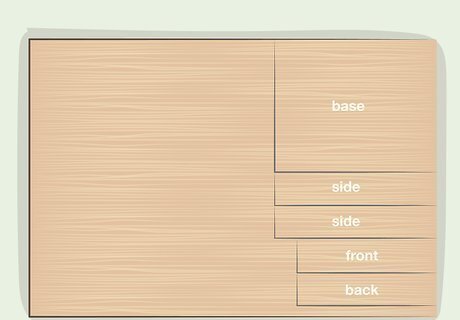
Mark the plywood for the base, front, back, and sides of the drawers. For the drawer sides, measure the length of the workbench and how deep you want the drawers to be. For the front and back, measure the width between the spacers and the depth of the drawers. For the base, measure the length of the bench and width between the spacers. Mark all of these measurements on the wood in pencil. The amount of wood you use depends on how many drawers you’re making. The depth of the drawers depends on how much storage space you want. For papers or light items, 3 inches (7.6 cm) would work. To store tools or larger items, make them at least 6 inches (15 cm).
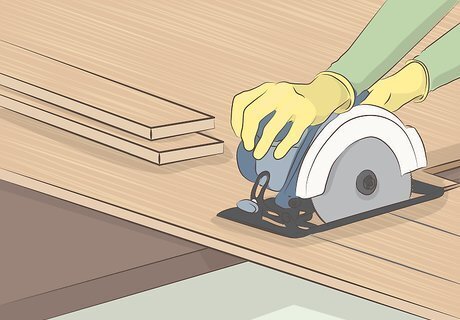
Cut the plywood for the drawer base and sides. Use a table saw, circular saw, or miter saw to make the cuts. Cut along each line you drew. Make sure you keep the saw straight so the cuts are exact. Wear gloves and goggles while operating the saw.

Screw the drawer sides together to make a rectangle. Arrange the side, front, and back pieces of each drawer to make a rectangle. Drill 2 screws into each corner to secure the pieces together. Repeat this process for all the drawers. If you prefer, you can drill pocket holes into each piece. This hides the screws better, but it isn’t a necessary step. If you won’t be storing heavy items in these drawers, then you could just use wood glue to fasten them together.

Squeeze a layer of wood glue along the bottom border of the drawer. Work along the border and squeeze out a line of glue. Use the same amount on each drawer you’re building. This is a quicker method of attaching the base. If you prefer, you can use screws on the base as well, instead of glue.

Press the base piece onto the glue. Line up the base board with the sides of the drawer. Then press the board down and apply pressure to make the glue stick. Run your hand around the border to ensure the board is attached at all points. For extra security, you can add nails or screws along the bottom to hold the base in place. If the panel is thin enough, you can also use staples.
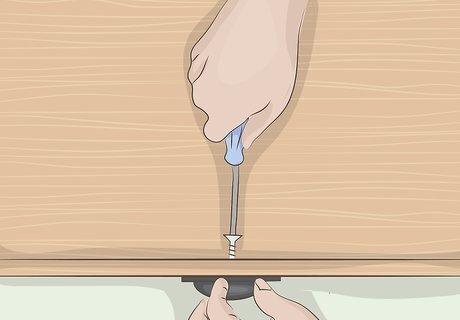
Install handles on the front of each drawer. Measure the distance between the screw holes in the handles you’re using and mark those points on the front of each drawer. Drill a hole into each point. Then, hold the handle over the holes and install the screws from the back. Repeat this for each drawer. You can buy handle kits from hardware stores.
Attaching the Drawers
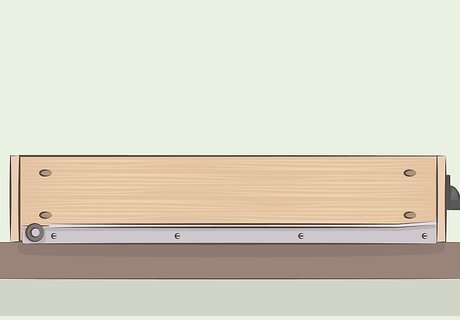
Attach the sliders to the bottom of each drawer. This hardware allows the drawers to slide in and out of the bench. Place a slider on each side of the drawers. Line them up with the bottom edge of the drawer, running from front to back, and make sure they’re straight. Then screw each one into place. Different slider kits may come with different instructions. Follow the directions on the product you use. Slider kits are available at hardware stores. Match the sizes to the size of the drawers you’re making. Get as many as you need for the number of drawers you’re making.
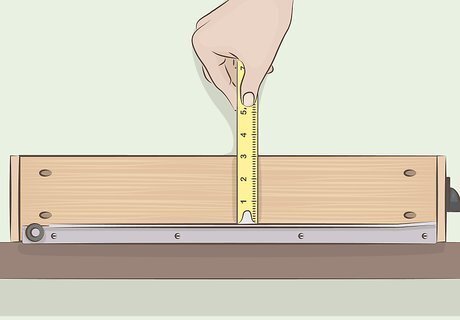
Measure the distance from the top of the drawer to the sliders. Use your tape measure and check the distance from the top of each drawer to the slider. If you made each drawer the same size, then this should be the same measurement on each one, but double check just to make sure. Write this measurement down so you remember it for the next step. If you made the drawers different sizes, then be sure to check the distance for each one.

Mark the distance for the slider mounts on each spacer. Take the distance you measured from the top of each drawer to the slider. Then, measure that distance down from the top of the workbench. Use a straightedge and make a line at this point to indicate where the slider mount should go. Repeat the process on all the spacers. If you’re installing multiple drawers down in a column, then measure the length from each slider to the next.
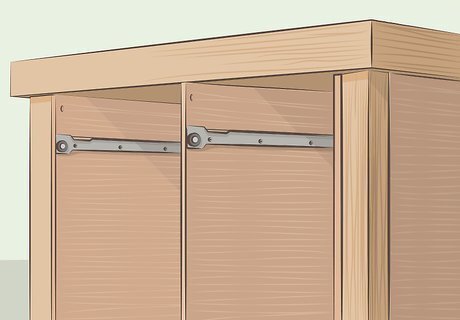
Attach the sliders to the sides of each spacer. Take the mounting sliders that correspond with the sliders on the drawers. Hold each one up to the line you drew and make sure it’s straight. Then screw the slider into place. Do the same for the corresponding slider on the other side. Repeat this for each drawer. Different spacer kits may have different installation instructions. Follow the directions provided.

Slide the drawers into place. Take each drawer and line up its sliders with the slider mounts in the bench. Tilt the front of the drawer down to insert it into the mount, the angle it up and slide it into position. When you’ve installed each drawer, then the upgrade is complete.




















Comments
0 comment